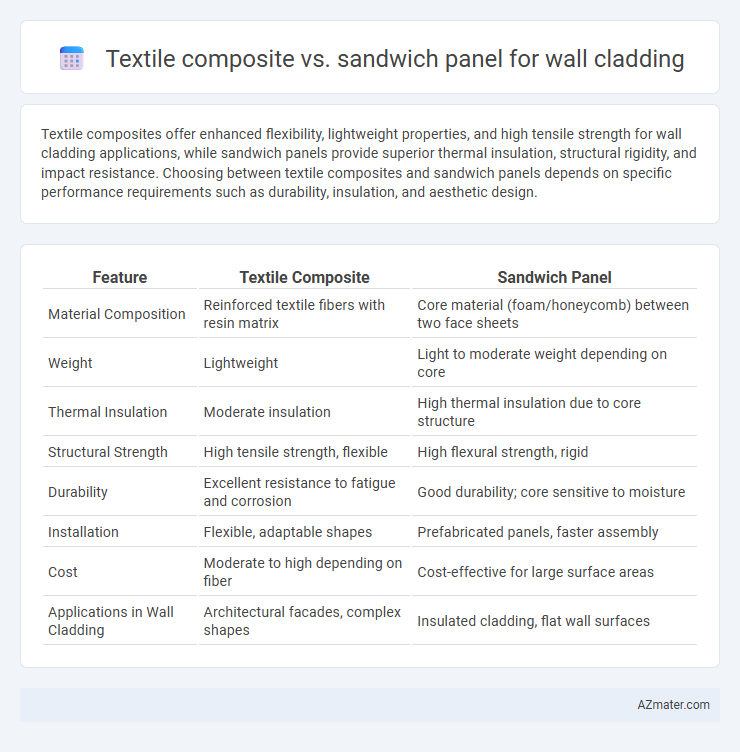Textile composites offer enhanced flexibility, lightweight properties, and high tensile strength for wall cladding applications, while sandwich panels provide superior thermal insulation, structural rigidity, and impact resistance. Choosing between textile composites and sandwich panels depends on specific performance requirements such as durability, insulation, and aesthetic design.
Table of Comparison
| Feature | Textile Composite | Sandwich Panel |
|---|---|---|
| Material Composition | Reinforced textile fibers with resin matrix | Core material (foam/honeycomb) between two face sheets |
| Weight | Lightweight | Light to moderate weight depending on core |
| Thermal Insulation | Moderate insulation | High thermal insulation due to core structure |
| Structural Strength | High tensile strength, flexible | High flexural strength, rigid |
| Durability | Excellent resistance to fatigue and corrosion | Good durability; core sensitive to moisture |
| Installation | Flexible, adaptable shapes | Prefabricated panels, faster assembly |
| Cost | Moderate to high depending on fiber | Cost-effective for large surface areas |
| Applications in Wall Cladding | Architectural facades, complex shapes | Insulated cladding, flat wall surfaces |
Introduction to Wall Cladding Solutions
Textile composite and sandwich panels serve as advanced wall cladding solutions offering enhanced durability and aesthetic appeal for modern architectures. Textile composites provide lightweight, flexible surfaces with superior tensile strength and environmental resistance, ideal for dynamic design requirements. Sandwich panels consist of layered cores like foam or honeycomb materials between rigid skins, delivering exceptional thermal insulation and structural rigidity suitable for high-performance building envelopes.
Overview of Textile Composite Panels
Textile composite panels for wall cladding consist of fiber-reinforced textile layers embedded in a resin matrix, offering high strength-to-weight ratios and excellent flexibility compared to traditional sandwich panels. These panels provide superior durability, enhanced impact resistance, and improved acoustic insulation, making them suitable for both interior and exterior applications. The integration of advanced fiber architectures in textile composites delivers tailored mechanical properties, ensuring efficient load distribution and long-term performance in architectural cladding systems.
Overview of Sandwich Panels
Sandwich panels consist of two outer metal sheets bonded to a lightweight core, often made of polyurethane, polystyrene, or mineral wool, providing high thermal insulation and structural rigidity for wall cladding. These panels offer exceptional strength-to-weight ratios, moisture resistance, and quick installation, making them ideal for industrial and commercial building envelopes. Their fire resistance and customizable thickness enhance energy efficiency and durability in diverse architectural applications.
Material Composition and Structure
Textile composites for wall cladding consist of fibrous reinforcements such as carbon, glass, or aramid fibers embedded in polymer matrices, offering high tensile strength and flexibility. Sandwich panels feature a core material like foam or honeycomb, sandwiched between two rigid face sheets made of metals, composites, or fiber-reinforced plastics, providing excellent thermal insulation and structural rigidity. The material composition of textile composites emphasizes lightweight performance and impact resistance, while sandwich panels prioritize durability, insulation properties, and load-bearing capacity through their layered structural design.
Thermal and Acoustic Performance Comparison
Textile composites offer superior thermal insulation due to their low thermal conductivity and ability to reduce heat transfer, making them highly efficient for wall cladding in energy-sensitive buildings. Sandwich panels, composed of rigid foam cores and metal facings, provide excellent acoustic attenuation by dampening sound waves, ideal for environments requiring noise reduction. While textile composites excel in maintaining consistent indoor temperatures, sandwich panels outperform in soundproofing, creating a balance between thermal comfort and acoustic performance.
Mechanical Strength and Durability
Textile composite wall cladding offers superior mechanical strength due to its high tensile properties and flexibility, making it resistant to impact and deformation. Sandwich panels provide excellent durability through their layered structure, combining stiff outer skins with a lightweight core that enhances load-bearing capacity and resistance to environmental factors. While textile composites excel in dynamic load absorption, sandwich panels maintain long-term structural integrity in harsh conditions, ensuring reliable performance in wall cladding applications.
Fire Resistance and Safety Features
Textile composites offer enhanced fire resistance due to their inherent non-combustible fibers and fire-retardant resin matrices, making them suitable for critical wall cladding applications where safety is paramount. Sandwich panels, typically composed of combustible core materials like polyurethane or polystyrene, often require additional fire-resistant treatments or barriers to meet stringent fire safety standards. Evaluating fire performance certifications such as ASTM E84 and EN 13501 is essential to selecting cladding materials that ensure structural safety and compliance in various building codes.
Installation Processes and Complexity
Textile composites offer flexible installation with lightweight materials that conform to complex wall geometries, reducing labor time and minimizing the need for heavy equipment. Sandwich panels involve prefabricated layers with rigid cores, requiring precise alignment and fastening systems, often increasing installation complexity and time. The simpler, adaptable installation process of textile composites often results in cost savings compared to the more structured and labor-intensive sandwich panel methods.
Sustainability and Environmental Impact
Textile composites for wall cladding offer enhanced sustainability through lightweight construction, reduced raw material consumption, and recyclability compared to traditional sandwich panels. Sandwich panels typically involve foam cores and metal facings, which present challenges in end-of-life disposal and higher embodied energy. The biodegradable potential and lower carbon footprint of textile composites contribute to greener building practices and reduced environmental impact.
Cost Analysis and Market Trends
Textile composites used in wall cladding offer cost advantages through lightweight materials and reduced installation time compared to traditional sandwich panels, which typically incur higher expenses due to multiple layers and core materials like foam or honeycomb structures. Market trends indicate a growing preference for textile composites driven by demand for sustainable, flexible, and corrosion-resistant facade solutions in commercial and residential sectors. Although sandwich panels remain favored for superior thermal insulation and structural strength, textile composite innovations are rapidly expanding market share by optimizing life-cycle costs and enhancing architectural design versatility.

Infographic: Textile composite vs Sandwich panel for Wall cladding
 azmater.com
azmater.com